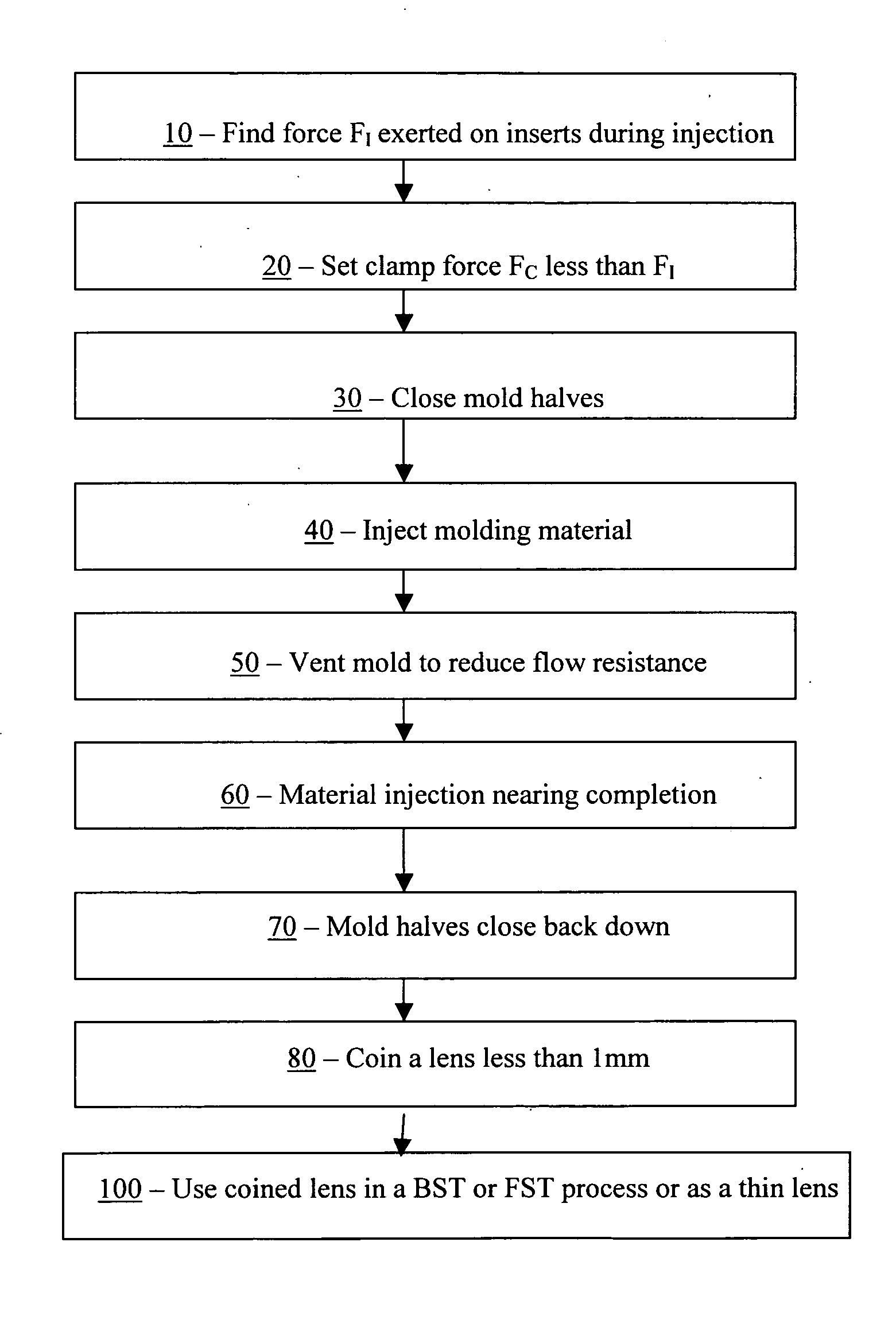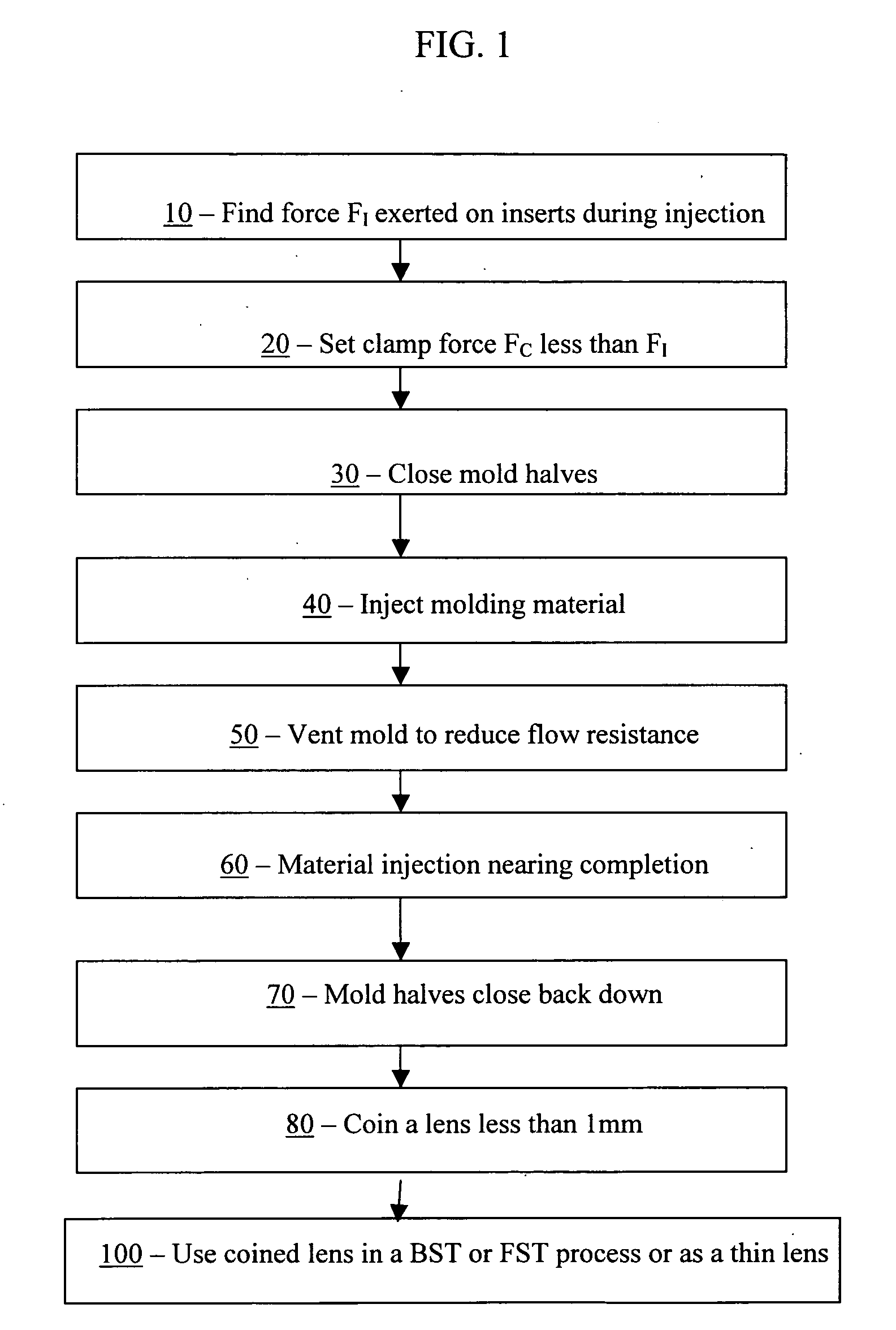Method of injection molding thin thermoplastic lenses
- Summary
- Abstract
- Description
- Claims
- Application Information
AI Technical Summary
Benefits of technology
Problems solved by technology
Method used
Image
Examples
example 1
[0029] A Cincinnati RoboShot was configured to operate at maximum injection speed of 5.9 inches per second (ips), maximum injection pressure of 24,000 psi and maximum clamp tonnage of 110 U.S. tons. The machine was equipped with a 2-cavity, 71mm diameter mold from APEX. One cavity was blocked, and the other held a 6-base stock plano steel insert set. Thin carriers were molded with Bayer DP1-1265 and Bayer 2407 under the following process parameters:
Mold Temperature:280 degrees F.Melt Temperature:595 degrees F.Injection Speed:5.9 ips - one stepPacking:12,000 psi - 2 sec; 10,000 psi - 3 sec;5,000 - 5 sec
The Bayer DP1-1265 resin produced the thinnest lenses having a center thickness slightly above 0.6 mm. Lenses with a 0.65 mm center thickness were common, thereby failing to achieve the objective of molding lenses about 0.5 mm. Since the carriers were thicker than desired, it followed that the BST yield ranged from 44% to 78%. Other problems included non-uniform thickness, base curv...
example 2
[0035] A further test was conducted with an Engel conventional high speed machine operating at the maximum 200 ton hydraulic clamp force and the maximum injection speed of 40 ips. The 2-cavity, 76mm diameter mold was used. Both GE OQ1030 (CD grade) and GE HF1110 (high flow) resins were used. The OQ1030 achieved an actual injection speed of 25 ips and carriers having a center thickness of 0.5 mm were obtained. For the HFI110,carriers with center thicknesses slightly under 0.6 were obtained. BST laminating tests of the resulting carriers in applying PHC (protected hard coat) resulted in a 90% yield.
[0036] The parts from the Engel machine were characterized by the presence of excess flash. During injection, it was observed that the parting line was forced open allowing the resin to flow out of the boundary of the mold inserts. At the same time, however, resin was easily able to flow across the inserts as the passage was wider and pressure from within the cavity was released. According...
example 3
[0037] A Nissei FN4000 having a 200 ton hydraulic clamp was configured to operate at 75% of maximum clamp force to obtain a better balance with the maximum injection speed of 132 mm / sec [5.2 ips]. Bayer DP1-1265 and GE OQ1030 were utilized in the example with a melt temperature of 595 degrees F and a mold temperature of 265 degrees F. The process was utilized to mold a pair of 76mm 6-base plano steel insert in a 60 second cycle. Due to excess flash, secondary processing including degating and die-cutting was needed to obtain the final carriers. However, the quality of the resulting carriers is almost on par with regular plano lenses, and is superior to those obtained from surfacing. Lens having a center thickness of about 0.56 mm were produced consistently. In a subsequent test of the carriers with full HMC stack, resulted in an 86% acceptable yield. The carriers resulting from this example are compared to surfaced carriers and thermoformed carriers in the following Table 3.
TABLE ...
PUM
 Login to View More
Login to View More Abstract
Description
Claims
Application Information
 Login to View More
Login to View More - R&D
- Intellectual Property
- Life Sciences
- Materials
- Tech Scout
- Unparalleled Data Quality
- Higher Quality Content
- 60% Fewer Hallucinations
Browse by: Latest US Patents, China's latest patents, Technical Efficacy Thesaurus, Application Domain, Technology Topic, Popular Technical Reports.
© 2025 PatSnap. All rights reserved.Legal|Privacy policy|Modern Slavery Act Transparency Statement|Sitemap|About US| Contact US: help@patsnap.com


